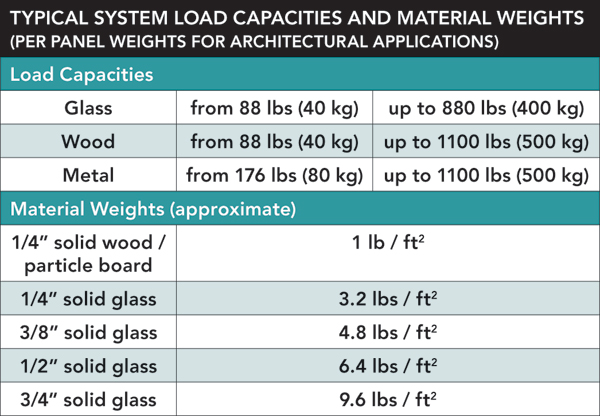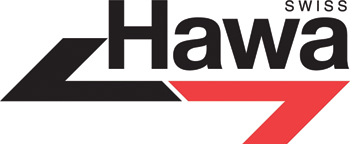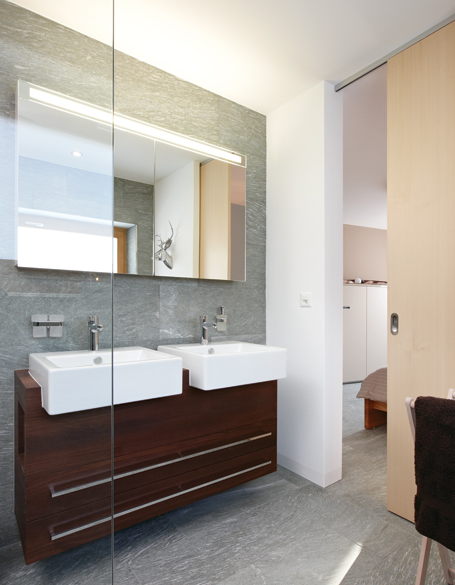Open Sesame: Specifying Top-Hung Sliding Hardware Systems
Top-Hung Applications, Seen and Unseen
Vanishing spaces, hidden doors, concealed hardware, and transparent glass panels—clearly, the benefits of top-hung sliding hardware systems are as much about what one doesn't see as what one does see. For this reason, many architects have come to understand sliding doors as a stealth benefit of their design concepts, adding functionality without furnishings and increasing drama without clutter.
The first question in the schematic design phase is, “How do we want the space to function and, where we have sliding door systems, what do we want those openings to do?” Another key planning consideration is the precise location and orientation of the door or wall panels, both in their deployed and retracted positions. These questions should be answered by the design team and client in order to identify and select the suitable sliding system for a given application. Experts in sliding hardware systems recommend the following five-question approach:
1. What's the function? This is simply the objective of the use, but it should also answer what the users or occupants expect the system to do—for example, hide a space, block a view, divide a room, replace a pivoting door, or another objective.
2. How should the doors or panels move? As discussed previously, it's not just a straight line or curve. Should they also stack, telescope, or open in unison?
3. How large is the opening? Ensure that any contents will fit through the allotted width, and that any egress allowances or other code-mandated minimum dimensions are met. Then consider the implications of comfort and practical use.
4. How is the hardware configured? The first question for sliding hardware is, where should it be mounted? Second, is it concealed or exposed—and will that work with the proposed location? Third, examine any code, design, and installation impacts of these choices.
5. What materials should be used? This covers the concealed and exposed hardware as well as the panels and their parking areas, in some cases. Look for finishes and colors that support the overall composition. Consider how function might expand the palette: Transparent and translucent panels may provide more benefits than opaque materials, for example.
As an example, consider the Chicago restaurant that needed the option to close off a party space by dividing a room that was nominally 10 feet wide. To match the establishment's aesthetics, keep renovation costs low, and provide for accessible hardware, the architects recommended the track be surface mounted. The panels of custom wood with a natural grain finish would deploy and stay motionless, suggesting a paneled wall matching its old-school, steakhouse atmosphere. When not in use, the panels would fold like an accordion to open the space, in less than a minute, with only modest effort on the part of the restaurant staff.
In this case the architects answered all five of the basic questions in order to provide a schematic design concept to the client and a sliding system specialty contractor. With input from each party, the design process could proceed with confidence.
Specifying a Detailed Sliding System
In addition to this basic approach to schematic design, a number of key details and engineering considerations must be answered for any top-hung sliding hardware system. Among those are the door weight, the number of panels, installation methods, door movement and placement, and suitable hardware selections.

Image courtesy of Hawa Americas Inc.
Door Weight
To understand the feasibility of the system and design concept, the project team should determine door or panel weight based on the panel materials and size—thickness as well as width by height dimensions.
Number of Panels
Both design intent and opening size influence the panel configurations for a sliding hardware system. Consultation with a manufacturer, door hardware consultant, or a seasoned installer will help confirm the most cost-effective and highest-functioning panel combination.
Installation Methods
Compare the benefits of ceiling-mounted versus side-mounted (wall-mounted) systems, as described above, and the benefits of recessing the top-hung hardware within the ceiling assembly.
Door Movement and Placement
The top-hung assemblies offer many movement options. They can be synchronized or independently operated, they may follow a straight path or curvilinear track system, and they may offer sliding and stacking operations. Door placement can include pocket designs, side-mounting on a wall, and they may include one or more stationary panels. Consider these options as a kit-of-parts, and review the optimal motions and orientations for the given use.
Hardware System Design
The tracks, trolleys, and suspension can be specified as a concealed hardware system or an exposed system with or without a fascia. The concealed look is sleek, minimal, and professional. A wall-mounted track can be left exposed for an industrial or loft-style feel, or it can be given a more finished look with an architectural fascia of wood or another matching material.
With these considerations and a specific architectural concept in mind, the architectural team is close to its goal of an effective top-hung sliding hardware selection.
Quality, Design, and Performance
As with any architectural assembly or engineered system, the quality of the products used should be considered in the selection and specification of sliding hardware. Durability and life-cycle performance are just as essential as purchased cost: When the architectural element moves, performance is considered based on how many cycles of use the system can tolerate over years and years of operation.
In terms of material performance, consider machined and cast hardware components versus the stamped sheet-metal products now on the market. Good systems tend to have tighter dimensional tolerances—the mark of well-controlled fabrication processes. Some architects specify ISO 9000 or similar third-party certifications for their manufacturers, another yardstick for control of their processes. Ask the sales representative whether the maker uses automated assembly technology, which often makes a more consistent product than manual assembly plants.
As for the component products, they are essential to the reliability of the system overall. If the manufacturer offers a track record of good performance and can document more frequent testing, suppliers have more confidence in their products. Labeling and documentation should indicate conformance to relevant benchmarks and standards, and the product should meet the requirements of jurisdictional codes and ADA guidelines. Last, the installer should be reputable and experienced. There's nothing worse than seeing a good product installed poorly by inexperienced trades that never got training from the manufacturer.
In general, the market for top-hung sliding hardware systems is competitive and reliable, thanks in part to a tradition of European engineering and manufacturing. Specified properly, these sliding systems add new dimensions to a building's design and interior functionality. The first step is to consider how the moveable elements will work, and to identify the correct solutions and applications to make the concept as user-friendly and adaptable as possible.
 |
| Hawa Americas Inc. is the U.S. subsidiary of Hawa AG, a Swiss manufacturer of precision sliding hardware systems. Hawa has been manufacturing high-quality sliding hardware for doors, walls, furniture, and exterior shutters for 50 years. Applications include sliding, folding, and stacking systems designed for use with wood, glass, or metal doors. www.hawa.com |









